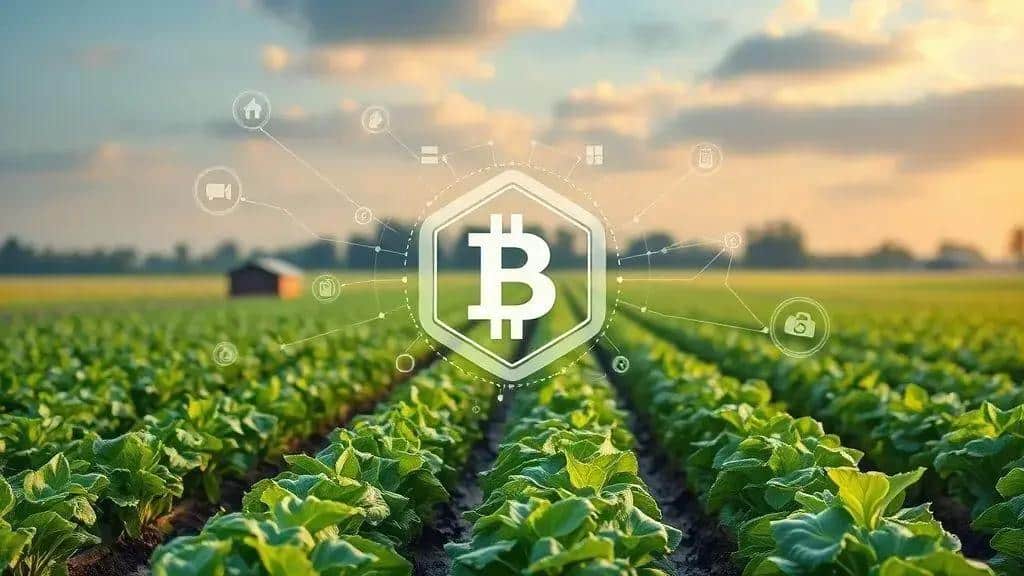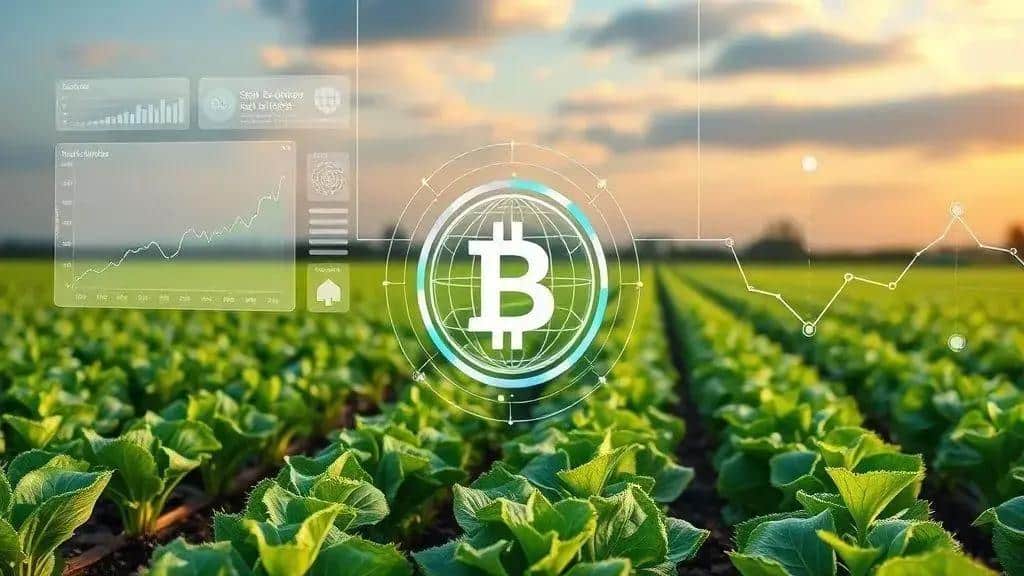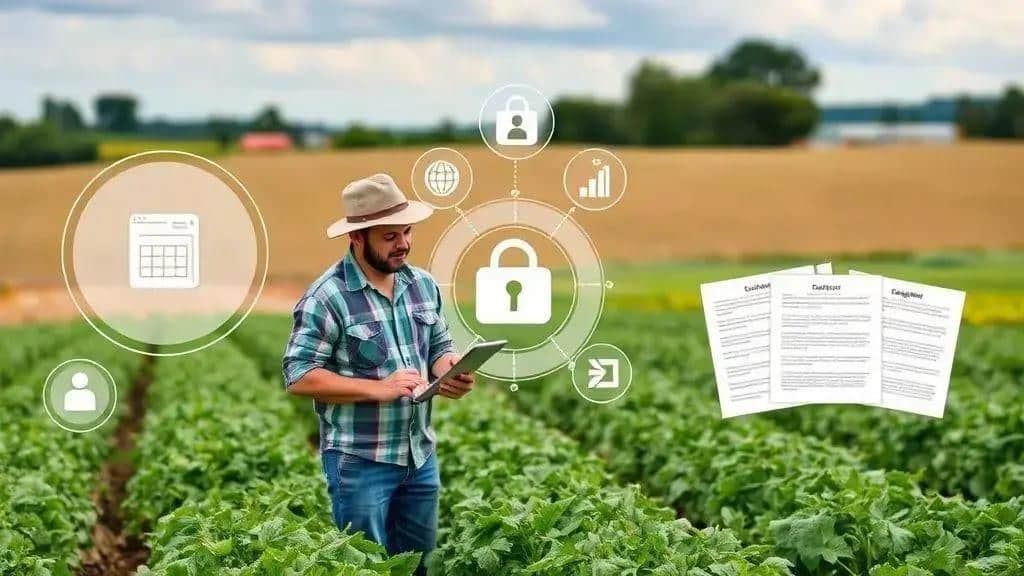Blockchain in agricultural supply chains: a game changer

Blockchain in agricultural supply chains enhances transparency, efficiency, and traceability, overcoming challenges such as costs and technological complexity, ultimately improving food safety and building consumer trust.
Blockchain in agricultural supply chains is emerging as a transformative force that could change how food gets from farms to tables. Have you ever wondered how transparency and efficiency can improve your food sourcing?
Understanding blockchain technology
Understanding blockchain technology is essential for leveraging its benefits in various industries, including agriculture. This technology is revolutionizing how data is stored and shared.
At its core, blockchain is a decentralized and distributed ledger that records transactions across many computers. This ensures that the data is transparent and secure, with no single point of failure. As farmers and producers look for more efficient ways to manage their supply chains, understanding this technology becomes imperative.
Key Characteristics of Blockchain
There are several key characteristics that make blockchain appealing:
- Decentralization: No single entity controls the data; it is shared across a network.
- Transparency: All participants can view the same information, which reduces fraud and errors.
- Immutability: Once data is entered into the blockchain, it cannot be altered, ensuring accuracy.
- Security: Each transaction is encrypted, making it hard for unauthorized users to access the data.
By integrating blockchain technology into agricultural practices, stakeholders can trace the origin of their products, improve the efficiency of inventory management, and enhance food safety protocols. Imagine being able to track a fruit’s journey from the farm to your table, knowing every step it took. That is the power of blockchain.
Applications in Agriculture
There are many exciting applications of blockchain in agriculture:
- Supply chain transparency, giving consumers insight into where their food comes from.
- Smart contracts that automate transactions based on preset conditions.
- Secure record-keeping for certifications and compliance with regulations.
As the agricultural industry continues to evolve, embracing blockchain technology will be crucial in overcoming challenges and satisfying consumer demands. This foundational understanding of the technology sets the stage for exploring more complex applications in the agricultural supply chain.
Advantages of blockchain in agriculture

Advantages of blockchain in agriculture are becoming increasingly clear as technology advances. Innovations in farming practices are necessary to boost productivity and meet the growing global demand for food.
One major advantage is improved transparency throughout the supply chain. With blockchain, every step from farm to table is recorded on a secure ledger. This means consumers can trace the origins of their food and verify its quality. When they know where their food comes from, trust and confidence increase.
Enhanced Efficiency
Blockchain technology also enhances efficiency in agricultural processes. Here are some notable benefits:
- Real-time tracking: Farmers can monitor their produce from the field to storage and delivery.
- Reduction in fraud: Accurate records help prevent food fraud and ensure product integrity.
- Streamlined transactions: Smart contracts automate processes and minimize delays in payments.
Furthermore, farmers can gather data from various points in the supply chain. This data aids in decision-making, ultimately leading to better yield management. As farmers adopt blockchain in agriculture, they can leverage insights to optimize their production strategies.
Cost Reduction
Another appealing aspect of blockchain is cost reduction. By decreasing the need for intermediaries, farmers can save money. They can sell directly to consumers, increasing profit margins. Moreover, fewer errors mean fewer costs associated with recalls and supply chain inefficiencies.
As agriculture faces various challenges, utilizing blockchain technology presents numerous advantages. It helps to build a more resilient and responsive agricultural sector, capable of adapting to the needs of consumers and the environment.
Real-world examples of blockchain applications
Real-world examples of blockchain applications in agriculture showcase the potential of this technology to transform supply chains. Many farmers and companies are already implementing blockchain solutions to improve operations.
One notable example is IBM’s Food Trust, a blockchain network that connects farmers, suppliers, and retailers. With this network, users can track the journey of food products from farm to store. This level of transparency helps reduce food waste and improves food safety.
Provenance
Another exciting application is Provenance, a platform that uses blockchain to verify the origins of products. This is especially important in the agriculture sector where consumers increasingly value transparency. For instance, a consumer can scan a code on a food package to view its complete history, ensuring it is sourced sustainably.
- Traceability: Products are easily traced back to their origin.
- Consumer trust: Verified information increases consumer trust in brands.
- Quality assurance: Knowing the source ensures higher quality standards.
A similar example is VeChain, which partners with farmers to monitor supply chains. By using blockchain technology, VeChain helps farmers track their goods, ensuring compliance with regulations while enhancing overall efficiency. The use of this technology allows for real-time data on product conditions during transportation, which helps maintain quality.
These real-world applications of blockchain demonstrate its versatility and effectiveness in the agricultural sector. Farmers who adopt these solutions can benefit from improved efficiency, enhanced traceability, and stronger consumer trust. As more agriculture entities discover the advantages of blockchain, we can expect its adoption to grow.
Challenges in implementing blockchain solutions

Challenges in implementing blockchain solutions in agriculture are significant, despite the many advantages this technology offers. Understanding these challenges is vital for stakeholders to ensure successful integration.
One major hurdle is the cost associated with setting up blockchain systems. The initial investment can be high, especially for smaller farms with limited resources. Additionally, maintaining the technology requires ongoing expenses, which can deter adoption.
Technological Complexity
The technological complexity of blockchain can also pose challenges. Farmers and agricultural workers may not have the necessary technical skills to operate blockchain systems effectively. Implementing user-friendly interfaces and providing training can help mitigate this issue.
- Limited understanding: Many stakeholders lack knowledge about blockchain technology.
- Initial resistance: Resistance to change is common in traditional industries such as agriculture.
- Integration difficulties: Existing systems may not easily integrate with new blockchain solutions.
Moreover, there are concerns about data privacy and security. Although blockchain is considered secure, vulnerabilities can still exist. Farmers may worry about exposing sensitive information on public ledgers, which could lead to data theft or unauthorized access.
Regulatory Uncertainty
Another challenge is the regulatory environment surrounding blockchain. Governments are still catching up with the fast-paced evolution of technology. Unclear regulations can create uncertainty for farmers considering blockchain integration. Navigating these regulations can be daunting, and many may hesitate to invest time and money without clear guidance.
As the agriculture industry explores the integration of blockchain technology, addressing these challenges will be essential. Stakeholders must collaborate to create solutions that promote understanding, ease of use, and compliance with regulations. It is through overcoming these challenges that the true potential of blockchain in agriculture can be realized.
In conclusion, blockchain technology holds great promise for revolutionizing agricultural supply chains. By improving transparency, efficiency, and traceability, it can help farmers and consumers alike. However, various challenges such as costs, technological complexity, and regulatory uncertainty must be addressed. As the industry navigates these hurdles, collaboration among stakeholders will be crucial to fully realize the potential of blockchain in agriculture. With thoughtful implementation, farmers can enhance their operations and build stronger connections with consumers.
FAQ – Frequently Asked Questions about Blockchain in Agriculture
What are the main benefits of using blockchain in agriculture?
Blockchain improves transparency, efficiency, and traceability in agricultural supply chains, helping farmers and consumers alike.
What challenges do farmers face when implementing blockchain solutions?
Farmers may face challenges such as high initial costs, technological complexity, and uncertainty regarding regulations.
How does blockchain enhance food safety?
By providing transparent tracking of products from farm to table, blockchain helps ensure that food is safe and sourced responsibly.
Can small farms afford to implement blockchain technology?
While initial costs can be high, there are scalable solutions and potential savings from increased efficiency that can benefit small farms.





